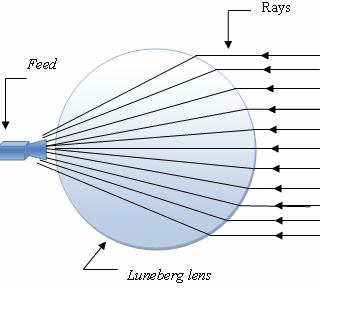Luneburg Antenna: Difference between revisions
No edit summary |
No edit summary |
||
| (3 intermediate revisions by the same user not shown) | |||
| Line 1: | Line 1: | ||
== The Luneburg Antenna == | == The Luneburg Antenna == | ||
<p> | <p>Luneburg lens is a new generation of antennas that has been developed since first being proposed in 1944. In the last few years it has developed applications in Microwaves, Communications and Telescopes area. [[Image:Luneburg Lens1.jpg|right]]</p> | ||
<p>The Luneburg lens is a spherical lens generally having a gradient of decreasing refractive index radially out from its center. The focusing properties of the Luneburg lens can be achieved through an infinite number of refractive-index solutions. </p> | <p>The Luneburg lens is a spherical lens generally having a gradient of decreasing refractive index radially out from its center. The focusing properties of the Luneburg lens can be achieved through an infinite number of refractive-index solutions. </p> | ||
== Applications == | == Applications == | ||
| Line 14: | Line 10: | ||
<p>'''Arecibo.''' A Luneburg antenna lens configured as a Retroreflector (developed by the CSIRO) is configured a subreflector feedpoint as a replacement for the 430Mhz line feed at Arecibo.</p> | <p>'''Arecibo.''' A Luneburg antenna lens configured as a Retroreflector (developed by the CSIRO) is configured a subreflector feedpoint as a replacement for the 430Mhz line feed at Arecibo.</p> | ||
== Reference == | == Reference == | ||
| Line 21: | Line 15: | ||
<p>[1] Rudolf K. Luneburg, Mathematical Theory of Optics. Providence, RI :Brown Unit, Press, Providence, RI, 1944, pp.189-213.</p> | <p>[1] Rudolf K. Luneburg, Mathematical Theory of Optics. Providence, RI :Brown Unit, Press, Providence, RI, 1944, pp.189-213.</p> | ||
[[Category:Fields,_waves_&_electromagnetics]] | |||
[[Category:Antennas]] | |||
[[Category:Microwave_technology]] | |||
Revision as of 21:24, 8 February 2012
The Luneburg Antenna
Luneburg lens is a new generation of antennas that has been developed since first being proposed in 1944. In the last few years it has developed applications in Microwaves, Communications and Telescopes area.
The Luneburg lens is a spherical lens generally having a gradient of decreasing refractive index radially out from its center. The focusing properties of the Luneburg lens can be achieved through an infinite number of refractive-index solutions.
Applications
SKA. Proposals utilising multiple arrays with ultra-broadband capability and wide viewing in the microwave radio spectrum are proposed.
Arecibo. A Luneburg antenna lens configured as a Retroreflector (developed by the CSIRO) is configured a subreflector feedpoint as a replacement for the 430Mhz line feed at Arecibo.
Reference
[1] Rudolf K. Luneburg, Mathematical Theory of Optics. Providence, RI :Brown Unit, Press, Providence, RI, 1944, pp.189-213.
